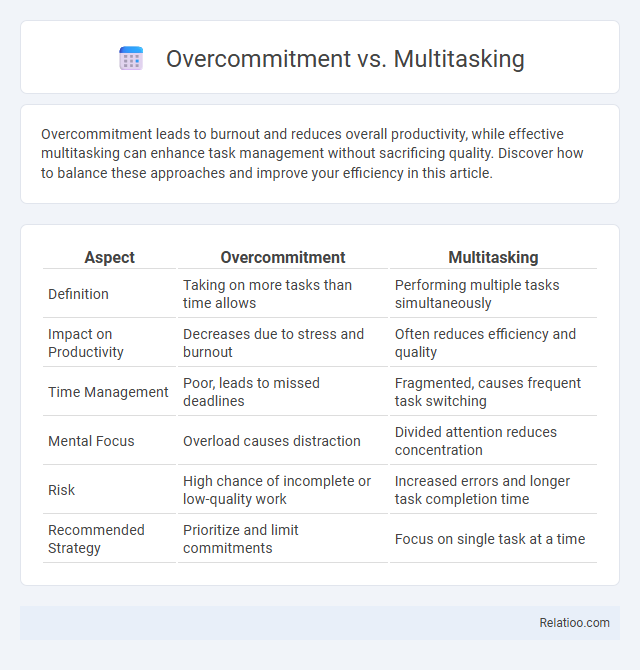Overcommitment leads to burnout and reduces overall productivity, while effective multitasking can enhance task management without sacrificing quality. Discover how to balance these approaches and improve your efficiency in this article.
Table of Comparison
| Aspect | Overcommitment | Multitasking |
|---|---|---|
| Definition | Taking on more tasks than time allows | Performing multiple tasks simultaneously |
| Impact on Productivity | Decreases due to stress and burnout | Often reduces efficiency and quality |
| Time Management | Poor, leads to missed deadlines | Fragmented, causes frequent task switching |
| Mental Focus | Overload causes distraction | Divided attention reduces concentration |
| Risk | High chance of incomplete or low-quality work | Increased errors and longer task completion time |
| Recommended Strategy | Prioritize and limit commitments | Focus on single task at a time |
Understanding Overcommitment: Definition and Signs
Overcommitment occurs when individuals take on more tasks and responsibilities than their available time and resources allow, leading to stress and decreased productivity. Signs of overcommitment include frequent feelings of overwhelm, inability to meet deadlines, chronic fatigue, and declining quality of work. Recognizing these symptoms early helps prevent burnout and promotes better workload management.
What Is Multitasking? Myths vs Reality
Multitasking involves attempting to perform multiple tasks simultaneously, but research shows it often reduces productivity and increases errors due to cognitive overload. Common myths suggest multitasking boosts efficiency, while reality indicates the brain switches focus rapidly, causing fragmented attention and slower overall task completion. Effective time management requires understanding that multitasking compromises quality, unlike focused task execution.
Key Differences: Overcommitment vs Multitasking
Overcommitment involves pledging more time and resources than one can realistically manage, leading to stress and burnout. Multitasking refers to performing multiple tasks simultaneously or switching rapidly between tasks, often reducing efficiency and focus. The key difference lies in overcommitment being a decision to take on excessive responsibilities, whereas multitasking is a behavioral approach to handling tasks.
The Risks of Overcommitment in Daily Life
Overcommitment risks include chronic stress, reduced productivity, and burnout due to consistently taking on more tasks than manageable. Multitasking often exacerbates inefficiency by dividing your attention, leading to mistakes and lower quality outcomes. Recognizing your limits and prioritizing tasks can help mitigate the dangers of overcommitment in daily life.
How Multitasking Impacts Productivity
Multitasking often leads to decreased productivity by causing frequent task-switching, which reduces focus and increases cognitive load. Overcommitment exacerbates this effect, as managing too many responsibilities dilutes attention and increases stress levels. Effective task management requires prioritizing responsibilities to avoid the productivity losses associated with multitasking and overcommitment.
Psychological Effects: Burnout and Stress
Overcommitment leads to chronic stress by constantly exceeding personal limits, increasing vulnerability to burnout characterized by emotional exhaustion, cynicism, and reduced performance. Multitasking divides attention between multiple tasks, elevating cognitive load and impairing focus, which intensifies mental fatigue and stress levels. Unlike overcommitment and multitasking, over-engagement involves deep psychological investment that, when excessive, also results in burnout through prolonged emotional strain and decreased resilience.
Strategies to Avoid Overcommitment
Overcommitment can lead to reduced productivity and increased stress by spreading your focus too thin compared to multitasking, which involves handling multiple tasks simultaneously but within manageable limits. Effective strategies to avoid overcommitment include setting realistic goals, prioritizing tasks based on importance and deadlines, and learning to say no to additional responsibilities that exceed your capacity. Establishing clear boundaries and regularly reviewing your workload helps ensure your commitments align with your available time and energy, maintaining optimal performance and well-being.
Improving Focus: Single-tasking Techniques
Multitasking often reduces productivity as it divides attention, leading to increased errors and slower task completion. Overcommitment exacerbates this by stretching focus across too many responsibilities, resulting in reduced efficiency and heightened stress levels. Adopting single-tasking techniques, such as time blocking and prioritizing high-impact tasks, enhances concentration and improves overall task performance.
Setting Boundaries to Prevent Overload
Setting boundaries to prevent overload involves clearly defining limits on tasks and commitments to avoid the pitfalls of overcommitment and multitasking. Overcommitment leads to excessive obligations that strain resources, while multitasking often reduces efficiency by dividing attention across tasks. Prioritizing single-task focus and learning to say no establishes healthy boundaries that maintain productivity and mental well-being.
Achieving Balance: Healthy Task Management
Overcommitment leads to burnout by allocating excessive time to too many tasks, while multitasking often reduces productivity through divided attention and frequent task switching. Achieving balance in healthy task management requires prioritizing key responsibilities, setting realistic goals, and focusing on single-task efficiency to enhance focus and output quality. Effective time allocation and boundary setting minimize stress and optimize overall performance in professional and personal commitments.

Infographic: Overcommitment vs Multitasking
 relatioo.com
relatioo.com